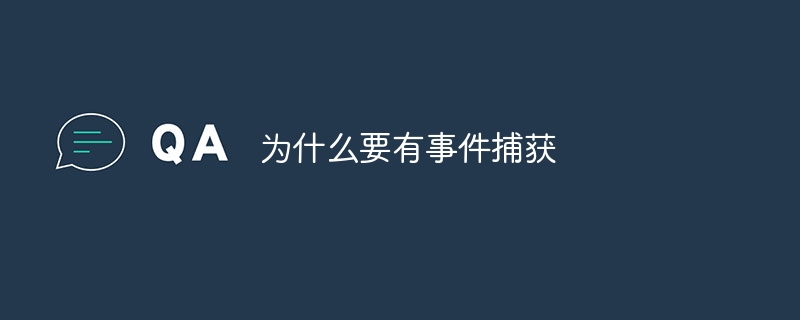
Because event capture exists to solve the problem of how to effectively deliver and process events when an event occurs in the DOM tree. It is an event model that handles events in the event bubbling stage. . By binding event handlers layer by layer and executing corresponding event handlers in the capture phase, it facilitates developers to obtain target elements and context information, customize event processing logic, effectively prevent event bubbling, and improve page response. speed etc.

The operating system for this tutorial: Windows 10 system, DELL G3 computer.
Event capture exists to solve the problem of how to effectively deliver and process the event when an event occurs in the DOM (Document Object Model) tree. It is an event model that handles events in the event bubbling stage.
In the traditional JavaScript event processing mechanism, events will start from the outermost element and pass upward to the target element layer by layer through the event bubbling stage. In this way, developers need to bind event handlers to each element that needs to handle events, and manually call the corresponding handler when the event occurs. The problem with this approach is that if the target element is located deep in the DOM tree, developers need to pass the event object down layer by layer, which will increase the complexity of the code and maintenance costs.
The emergence of event capture solves this problem. By binding event handlers layer by layer starting from the outermost element before the event bubbling stage, and executing the corresponding event handlers during the capture stage, developers can easily obtain target elements, context information, and custom events. Processing logic, effectively preventing event bubbling, and improving page response speed, etc.
Specifically, the functions of event capture are as follows:
Conveniently obtain the target element and contextual information: During the event capture phase, developers can easily obtain the attributes of the target element when the event occurs, Information such as location, as well as contextual information related to the target element. This information can be used for further processing and operations, such as determining the type and location of the target element. By passing the event object down layer by layer in the event capture phase, developers can obtain the contextual information of the event to facilitate more sophisticated and complex operations.
Effectively prevent event bubbling: In the event model, when an event occurs, it will be passed down layer by layer starting from the outermost element. This process is called event bubbling. If the developer wishes to prevent the event from bubbling, the event handler can cancel the event's default behavior and prevent the event from bubbling. By performing corresponding processing in the event capture phase, events can be effectively prevented from bubbling and unnecessary processing and operations can be avoided.
Customized event processing logic: Developers can customize event processing logic during the event capture phase. For example, when a user clicks a button, some preprocessing operations can be performed during the event capture phase, such as verifying user permissions, determining user identity, etc. If certain conditions are met, further processing of the event can be suspended, or some additional operations can be performed. This customized processing logic can expand event processing functions and improve development efficiency and flexibility. During the event capture phase, developers can flexibly design event processing processes and logic to meet actual needs.
Improve page response speed: During the event capture phase, developers can add some optimization strategies to the event handler, such as caching calculation results, avoiding unnecessary DOM operations, etc. These optimization strategies can increase page response speed and improve user experience. By optimizing event handlers and reducing unnecessary calculations and operations, you can speed up page response and improve user experience.
In short, event capture exists to solve the problem of how to effectively deliver and process events in the DOM tree. By binding event handlers layer by layer and executing corresponding event handlers in the capture phase, it facilitates developers to obtain target elements and context information, customize event processing logic, effectively prevent event bubbling, and improve page response. speed etc.
The above is the detailed content of Why event capture is needed. For more information, please follow other related articles on the PHP Chinese website!




